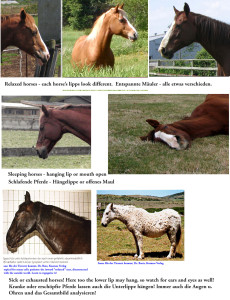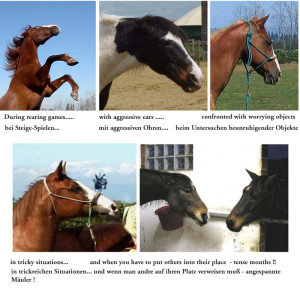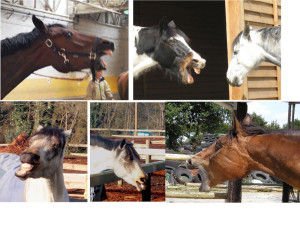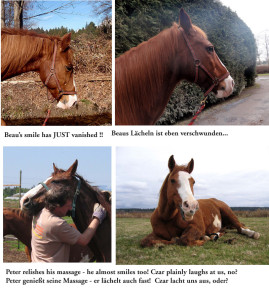Understand your Horse – Part 16
|
|
Ihr Pferd verstehen – Teil 16
|
The Mouth 2
- In the last part we looked at the function of the horse’s mouth, and saw what foals express in terms of emotion and communication by “snapping” or “teeth clapping”.
7) Mouth neutral and relaxed:
- Here we see mouths without special expression – the horse is in an emotionally neutral state. As each horse has a different face, so are the lips held in different ways.
|
|
Maul 2
- Im letzten Teil haben wir hauptsächlich die Funktion des Pferdemauls betrachtet, sahen aber auch, wie ein Fohlen seine Gefühle durch „Leerkauen“ den Herdenmitgliedern mitteilt.
7) Maul neutral und entspannt:
- Hier sehen wir Mäuler ohne besonderen Gefühlsausdruck – das Pferd ist emotional neutral. Da jedes Pferd ein besonderes Gesicht hat, sehen ihre Lippen auch unterschiedlich aus.
|
|
|
- When a horse is totally relaxed his lips are loose. When dozing, the lower lip may droop quite pronouncedly, and when the horse is sleeping lying flat, the mouth may also drop open.
- Again (as we did when analyzing the expression of the horse’s ears and eyes) we must check however that a hanging lower lip is not part of the expression of exhaustion or sickness. The horses in the bottom row of the picture are sick!
8) Jaws held tensely open with fully exposed teeth:
- This is the clear opposite of a relaxed mouth and an unmistakable bite threat!
|
|
- Wenn ein Pferd total entspannt ist, sind die Lippen locker. Wenn es döst, kann die Unterlippe deutlich herunterhängen, und wenn ein Pferd flachliegend schläft, ist das Maul auch manchmal offen.
- Genau wie damals, als wir den Ausdruck der Ohren und Augen der Pferde analysiert haben, müssen wir aber auch hier aufpassen, daß eine hängende Unterlippe nicht Teil von Erschöpfung oder Krankheit ist. Die Pferde in der unteren Bildreihe sind krank!
8) Weit offenes Maul mit gebleckten Zähnen:
- Das ist das klare Gegenteil eines entspannten Mauls und eine unmißverständliche Beißdrohung!
|
|

|
- In the picture on the far right you see that even though the horse is preparing for a kick and his head is not directed in the antagonist’s way, it nevertheless expresses the same aggression.
9) Tight lipped mouth:
- A tight-lipped mouth may also show aggression, but the situation has not yet escalated to a bite-threat and no teeth are shown. The lower lip is tense and often the nostrils are pinched as well. In situations where one horse warns off another one like this, the ears will of course also be flattened, as we saw previously, when learning the “language” of the ears.
|
|
- Im Bild ganz rechts sieht man, daß, obwohl das Pferd schon im Begriff ist auszukeilen und sein Kopf gar nicht in Richtung Gegner zielt, es dennoch mit dem Maul genauso seine Aggression ausdrückt.
9) Angespannte Maulpartie:
- Verkniffene Lippen zeigen auch Aggression an, aber die Situation ist noch nicht bis zur Beißdrohung eskaliert und die Zähne sind noch nicht entblößt. Vor allem die Unterlippe ist verkniffen und oft auch die Nüstern. Wenn ein Pferd so seinen Gegner warnt, sind natürlich auch die Ohren angelegt, wie wir schon früher bei „aggressiven Ohren“ sahen.
|
|
|
- In the picture on the right bottom you see a gentle warning: „stay away from my bucket!“, – ears flattened, but the mouth is quite relaxed! This is probably due to the fact that those two horses, stabled in neighbouring stalls, are good friends and the discussion about the bucket is just a gentle reminder. Also, as the ears of the other are clearly submissive and peaceful, more escalation is not necessary.
- A stiff, tensed mouth region, when you are working or playing with your horse, is always a reason to check the status of your relationship:This could also be an expression of either tension, fear or pain – and in all of those cases we should help our partner to better his situation.
- Of course, when the horse is making a happy crinkle nose, like we saw in Blog 14, the lower lip is also not hanging down (as when relaxed), but then for a very different reason! So again we must take in the whole picture to understand our horse’s facial expression.
|
|
- Im Bild rechts unten sieht man eine sanftere Warnung: “bleib weg von meinem Eimer!” – hier sind die Ohren zwar angelegt, aber das Maul ist entspannt! Vermutlich kommt das daher, daß diese beiden Pferde, die ja nebeneinander wohnen, ganz gute Freunde sind, und die Mahnung betreffs Eimer nur ein zarter Wink ist, wer hier wo fressen darf. Da die Ohren des anderen auch deutlich beschwichtigend sind, ist eine Eskalation ja nicht nötig.
- Wenn Sie aber so eine angespannte Maulpartie bei der Arbeit mit Ihrem Pferd oder beim Spielen sehen, dann sollten Sie immer den Stand Ihrer Beziehung prüfen: es könnte der Ausdruck von einem verspannten Verhältnis oder von Angst oder Schmerz sein – in all diesen Fällen kann man ja seinem Partner helfen, die Lage zu verbessern.
- Wenn das Pferd seine Nase glücklich kräuselt, wie wir im Blog 14 gesehen haben, dann hängt die Unterlippe natürlich auch nicht entspannt herunter, aber aus ganz anderen Gründen! Wieder müssen wir also immer das ganze Bild ins Auge fassen, um die Mimik des Pferdes zu verstehen.
|
|
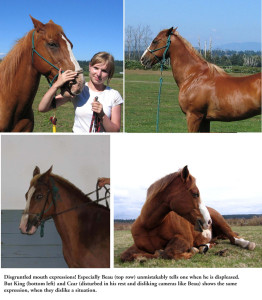
|
10) Disgruntled mouth:
- I mentioned often before that your horse will speak to you more and more clearly, when he realizes that you are listening! There is absolutely NO doubt about Beau’s mood, when he is displeased! He can grimace as expressively as any teenager… and he doesn’t like it any better, when I then burst out laughing!!
|
|
10) Mißmutiges Maul:
- Ich habe immer schon behauptet, daß Ihr Pferd, je mehr es fühlt, daß Sie wirklich zuhören, desto mehr zu Ihnen sprechen wird! Es besteht absolut KEIN Zweifel über Beaus Laune, wenn er sauer ist! Er zieht genauso deutliche Grimassen wie ein verstimmter Teenager… und er mag es genauso wenig, wenn ich dann in Gelächter ausbreche!!
|
|
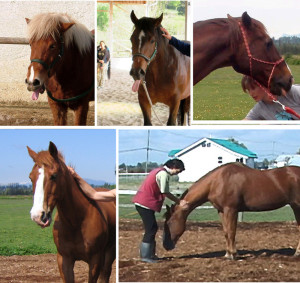
|
11) Chewing, licking and showing the tongue:
- This is what you should mainly learn to watch for and understand, when communicating with your horse. All of these movements of the mouth, licking, chewing and showing the tongue, are substitute activities derived from eating behaviour. As such they are peaceful. Eating behaviour never goes together with flight or fight.
- When chewing or licking occurs in a confrontation with a clearly higher-ranking horse, then it carries the meaning (resembling the foal’s snapping) “please leave me alone, IAM trying!” – a message of humility, submission and respect. When the horse is in a training situation with you and feels over-challenged, he will do the same, thus also expressing insecurity about what to do. Natural horsemanship trainers often tell you that it means the horse is “thinking about” a solution, but we should be careful not to overlook that he may be telling you that he is at a total loss. That, of course, would not be a happy feeling, and we should help!
- Especially when the tongue is stuck out at the same time, this could be a desperate call for help: “I don’t want to do anything wrong – but I don’t get what you want from me!”
- When the horse sticks out his tongue, he usually is at a great loss – also when riding!! If you don’t want to destroy the trust between you and your horse, you must tread lightly, take a step back in your demands, explain more clearly, and help and re-establish the fun. (Read the Blogs in the H.E.M. category again!)
- The substitute action of chewing or licking can also be an attempt to calm HIMself down, when he feels over-challenged and is getting nervous. Or they can be cautious signs of relaxation, and a sign of beginning cooperation “I am thinking about it, I guess one could try it!”
- In all these cases one should de-escalate the situation, give the horse a pause for reflection and show respect for his striving for harmony.
- When chewing and licking are shown with a dropped head and neck (when you offer him a break), it is a sign of contentment and repose.
|
|
11) Kauen, Lecken und Zunge zeigen:
- Diese sollte man hauptsächlich zu sehen und verstehen lernen, wenn wir mit unserem Pferd echte Verständigung suchen. Alle diese Maulbewegungen sind Übersprunghandlungen von Freßverhalten. Als solche sind sie friedlich, da Freßverhalten nie mit Aggression oder Flucht dahergeht.
- Wenn man Kauen oder Lecken in einer Konfrontation mit einem deutlich höher-rangigen Pferd beobachtet, dann bedeutet es (ähnlich wie das Leerkauen des Fohlens) „bitte tu mir nichts, ich bemühe mich ja!“ – auch eine Botschaft von Demut, Unterwürfigkeit und Respekt. Wenn das Pferd sich in einer Trainingssituation überfordert fühlt, weist Lecken auch auf Unsicherheit hin, da es nicht genau weiß, was es tun soll. Natural Horsemanship Trainer sagen oft, es bedeutet, daß das Pferd über eine Lösung „nachdenkt“, aber wir sollten vorsichtig sein und nicht übersehen, daß es auch heißen könnte, daß es total ratlos ist. DAS wäre natürlich kein glückliches Gefühl und wir sollten helfen!
- Vor allem, wenn die Zunge herausgestreckt wird, könnte dies ein Hilfeschrei der Unsicherheit sein: „ich will ja nichts falsch machen – aber ich habe keine Ahnung, was von mir verlangt wird!“
- Wenn ein Pferd die Zunge heraus streckt, ist es meist sehr ratlos – auch beim Reiten!! Wenn Sie das Vertrauen, das zwischen Ihnen und Ihrem Pferd besteht, nicht zerstören wollen, dann müssen Sie in solchen Situationen Ihre Anforderungen zurücknehmen, besser erklären, mehr helfen und den Spaß an der Sache wieder herstellen (lesen Sie noch einmal die Blogs in der H.E.M. Category).
- Diese Übersprunghandlung des Kauens und Leckens kann auch ein Versuch der Selbstberuhigung sein, wenn es sich überfordert oder nervös fühlt. Oder es ist ein Zeichen von vorsichtiger Entspannung, eine beginnende Kooperationsbereitschaft: „ich denke drüber nach, man könnte es versuchen“ .
- In all diesen Fällen sollte man die Situation entschärfen, eine Besinnungspause einlegen, und dem Pferd für sein Streben nach Harmonie Respekt erweisen.
- Wenn Kauen und Lecken während einer Pause mit einem gesenkten Kopf und Hals auftreten, sind sie ein Zeichen der Zufriedenheit und Entspannung.
|
|
|
12) Yawning:
- The function of yawning is, like for humans, to fill up the lungs with air and take in more oxygen – mostly because of tiredness.
- But when you see it while working or playing with your horse, it is equally most often a substitute action. It shows that a situation has eased, it shows relief on the part of the horse, it marks the end of a crisis. What the horse is saying with it is “now one can relax, one could almost go to sleep”. Therefore it also serves as a signal for de-escalation to others. It grants the higher rank to others and shows peaceful intentions.
- On the right, top and bottom, you see tired horses yawning. On the top left the horse is in a clinic situation, and has mastered his task – he is saying “I’m glad all went well – now I can relax!”. At the bottom centre, the horse is signalling his peaceful intentions across the fence to another horse, while the expression on the bottom left, where the horse moves his jaws sideways while yawning, is said to express boredom.
|
|
12) Gähnen:
- Die Funktion des Gähnens ist, wie beim Menschen, die Lungen mit Luft zu füllen und Sauerstoff nachzutanken – meist aus Müdigkeit.
- Wenn man es während der Arbeit mit dem Pferd sieht, ist es aber oft auch eine Übersprungshandlung. Es zeigt, daß eine Situation sich entspannt, Erleichterung des Pferdes, das Ende einer Krise. Das Pferd sagt “jetzt kann man entspannen, man könnte fast schlafen“. Daher dient es auch den anderen als Signal der De-eskalation. Es ist ranggewährend, und zeigt anderen friedliche Absichten.
- Rechts im Bild, oben und unten, sieht man müde Pferde gähnen. Das Pferd oben links ist in einer Workshop Situation und hat seine Sache gut gemacht – es sagt „Gottlob ging alles gut – nun kann ich entspannen!“ Das Pferd unten Mitte signalisiert seine friedlichen Absichten an ein anderes Pferd über den Zaun hinweg, während man von der Gähnbewegung, bei der das Pferd seine Kinnlade seitlich verschiebt (unten links), behauptet, daß es Langeweile ausdrücken soll.
|
|
|
13) Licking as sign of tenderness:
- Mothers lick their foals, but I have also often observed that horses will lick a close friend as sign of tenderness. In the picture you see King at his first meeting with little Oliver – it was it was irresistibly cute, love at first sight for him! First he sniffed, and then he licked, and the mini returned the attention by grooming him on the cheek (he couldn’t reach any higher!). It was irresistibly cute!King is a great “licker” anyway: when he has performed well and especially when he gave rise to real jubilation on my part, he offers to lick – first my hand (very much as sign of relief) and then, when he receives continuous praise for the good boy he was, he sometimes can hardly contain himself! He licks up my arm, my face, my neck and shoulders – and I can save myself the evening bath!
|
|
13) Lecken – Ausdruck von Zärtlichkeit:
- Stuten lecken ihre Fohlen, aber ich habe auch oft beobachtet, daß ein Pferd einen guten Freund zum Ausdruck der Zärtlichkeit leckt. Im Bild sieht man King bei seinem ersten Treffen mit dem kleinen Oliver – für ihn war es Liebe auf den ersten Blick! Nach dem ersten Beschnüffeln fing er an ihn zu lecken, und der Mini erwiderte die Zärtlichkeit durch putzen seiner Kinnbacke (höher hinauf konnte er nicht reichen!). Es war unglaublich süß! King ist eh ein großer „Lecker“: wenn er richtig gut war und vor allem, wenn ich dann laut jubele, dann beleckt er mich – zuerst die Hand (auch ein Zeichen der Erleichterung), und wenn er dann weiterhin Lob für seine tolle Leistung erhält, kann er oft kaum an sich halten! Er leckt den Arm hinauf, Hals, Schultern, Gesicht – und ich kann mir das abendliche Bad sparen!
|
|
|
14) A smile!
- Beau is one of those horses who can truly smile: when he is happy and content with life in general, the corners of his lips go up “yeah! This is how life should be!” Beau smiles often (and blows bubbles at the same time when ecstatically happy while playing), but unfortunately his happiness does not include cameras, and I can’t fool him, of course. So no matter how much I try to hide it… the moment the lens is pointed at him, the true smile vanishes. So in the picture I can only show you the “almost-smile”! I will keep trying – but unless I get a Tele-lens helper in the bushes, I don’t think we can record this sweet memory on film.
- If your horse chews, licks and smiles, you are on the right path.
Let’s move on to the horse’s neck in the following Blog!
Read on !!!
|
|
14) Ein Lächeln!
- Beau ist eins der Pferde, der ein richtiges Lächeln zeigt: wenn er glücklich und mit dem Leben im Allgemeinen zufrieden ist, zieht er seine Mundwinkel hoch „ja! So sollte das Leben sein!“ Beau lächelt oft (und wenn er beim Spielen besonders glücklich ist macht er dabei auch Spuckebläschen), aber leider schließt dieses Glücklichsein keine Kamera mit ein – und ich kann ihn nicht überlisten. Egal wie sehr ich es zu vertuschen suche… sobald die Kamera in seine Richtung zielt, verschwindet das Lächeln. Ich kann hier also nur ein „Fast-Lächeln“ zeigen. Ich werde es weiter versuchen, aber solange ich keinen Tele-Objektiv Helfer im Gebüsch habe, werde ich diese niedliche Erinnerung wohl nicht auf Film bannen können.
- Wenn Ihr Pferd kaut, leckt und lächelt, sind Sie auf dem richtigen Weg.
Weiter gehts mit dem Hals des Pferdes im nächsten Blog!
Lesen Sie weiter !!
|

